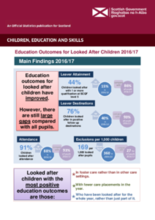Introduction
Local authorities have a responsibility to provide support to a group of vulnerable young people, known as ‘looked after children’. A young person may become looked after for a number of reasons, including neglect, abuse, complex disabilities which require specialist care, or involvement in the youth justice system.
This publication links school and social work data to present information on school leaver attainment and the post-school destinations of looked after young people who left school in 2016/17. This year it includes the school attendance and exclusion rates of all looked after children. The school attendance and exclusion rates of all looked after children are only included every other year, and will next be collected in 2018/19 and reported in 2020.
This publication also includes experimental statistics on achievement of Curriculum for Excellence levels for looked after children and young people, on which data was published for the wider school population in December 2017.
Executive Summary
The proportions of looked after school leavers achieving all levels of qualification have improved since 2009/10. The percentage of children looked after for the full year achieving at least SCQF level 5 has increased from 15% in 2009/10 to 44% in 2016/17. Looked after school leavers continue to have lower attainment than other school leavers, but the gap between children looked after for the full year and all school leavers has narrowed from 62 percentage points in 2009/10 to 42 percentage points in 2016/17.
While looked after children are less likely to be in positive destinations nine months after leaving school, the gap between children looked after for the full year and all school leavers has narrowed from 45 percentage points in 2009/10 to 17 percentage points in 2016/17.
The school attendance of looked after children has improved since 2009/10, but improvement has stalled and it is still below that of all pupils.
The exclusion rate for children looked after for the full year has nearly halved. The rate is still much higher than for the general school population, but the gap is narrowing steadily.

